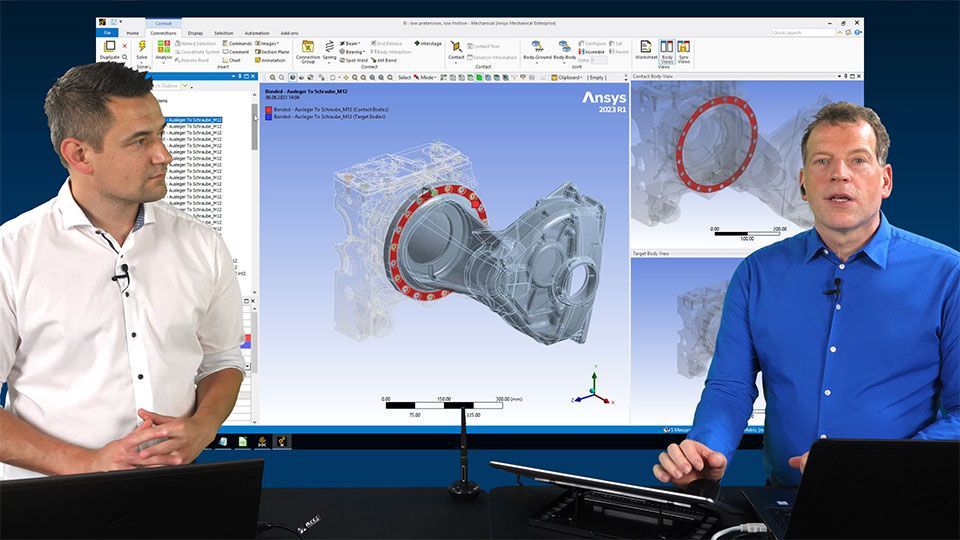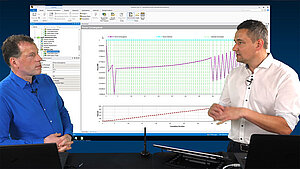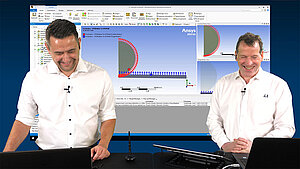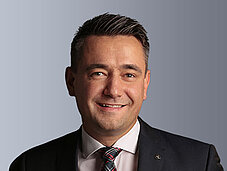Let's Simulate: The wonderful world of convergence


Let's Simulate is an exclusive format for customers of the CADFEM learning subscription.
Dr. Hendrik Donner and Andre Stühmeyer are discussing what keeps everyone from structural mechanics busy: convergence. Those who understand it love to work with it, but for those who don't, it can be a source of grey hair. Hendrik and Andre shed light on various aspects from a mix of background knowledge and practical experience, take a convergence challenge, and reveal some tips that even experienced Ansys users may not know. Don't miss it! Please note: lecture language is German!
Designated Site of usage and contact
Preparation Trainings
This series is based on the training courses "Nonlinear Simulations with Ansys Mechanical" and "Contact Modeling with Ansys Mechanical", which we definitely recommend attending in advance!
Detailed agendas of this series
Season 1

- The first convergence challenge: A structure without bending stiffness
- Searching the seemingly critical location
- Discussion on time step control
- Quasi-static calculations as an insider tip
- The right setting - the first step is often the hardest

- Force convergence explained in the solution information
- Degressive vs. progressive
- Line search – your friend
- Creating a force-displacement diagram to visualize negative stiffness
- What happens when stiffness approaches zero

- Importing the force-displacement curve into Libre Office
- Solutions are not always unique
- Sometimes luck helps, even with force-controlled calculations
- Calculating the task by using stabilizing inertial forces
- What is the best value for stabilizing numerical damping?
- How to manupulate convergence criterias and when it's necessary

- Consistent loads vs. follower loads
- Searching and explaining Follw201 in the help section
- Using restarts to quickly identify the cause of convergence issues
- Newton-Raphson residuals help identify the problem region
- Calculation with an unsymmetric matrix and when this offers advantages

- First check of contacts in a complex component group
- Discussion on settings for nonlinear contacts
- Initial checks with the contact tool - this should be done before the calculation
- Why it’s good to avoid over-determination
- The initial contact state

- A discussion on what is an acceptable penetration
- How to interpret convergence with contact trackers
- How to find out which contact has not converged
- Insider tip: pair-based force convergence
- Again a brief word on the line search algorithm

- Modal analysis can provide important hints
- A brief discussion on the pinball radius
- The first step is always the most difficult one - why?
- A valuable hint: Are there unwanted internal forces at the beginning?
- Offset settings: the impact on convergence

- Options for setting the initial state in contacts
- "Adjust to touch" helps with convergence, but what does it actually do with penetration?
- When to use „Ramped Effects“ or „No Ramping“ for good convergence
- The setting for the "perfect" initial contact for each location in the contact zone
- Comments on the practical relevance of Bolt Thread Modeling

- A discussion on the contact behavior and its mesh
- Observing the contact tracker for contact stiffness
- What to do when criteria for defining contact and target contradict
- How to also define rigid bodies as contact
- Effective settings of contact stiffness for good convergence
- Announcement of the „convergence challenge“ - André vs. Hendrik

- Splitting the contact zone and defining contact and target
- It didn't converge - searching for the cause
- Calculation with Normal Lagrange and debugging during the computation
- Does the Mortar contact converge better? What's the difference in the computation?
- Tips for setting the initial time step
- Situations in which contact stiffness is used even with Normal Lagrange

- Comparison and discussion of the previous strategies
- Switching to solver setting "symmetric": what difference does it actually make?
- Exciting: Nodal-projected contact in combination with the solver setting "unsymmetric"
- And: Nodal-projected contact and "symmetric"? Not a good idea, or is it?
- Final comparison of results and convergence of all variants; summary

- How contacts at gauss points work and affect convergence
- The challenge of contacts at sharp edges
- Nodal normal from contact / normal to target / nodal-projected
- Using edge contacts as additional contacts to improve convergence
- Should you invest your time in creating CAD blends or in contact settings?

- Implicit vs. Explicit
- How strongly does the u-p formulation in the material affect convergence?
- Contact stiffness in the context of impact problems
- Dynamic calculation with the implicit solver - time steps are very important
- A brief excursion into energy conservation
💡 Let's Simulate - What is it?
Engineering software in action in series format
An exclusive service for CADFEM Learning Subscription customers.
Based on the "Let's Play" approach - known from the video game world - you will experience simulation software in action in this format. You look over the shoulders of experts as they work on the simulation model. In-depth engineering. Practical tips from years of experience. Each series with its own thematic focus.
Your Trainers

Dr.-Ing. Hendrik Donner






